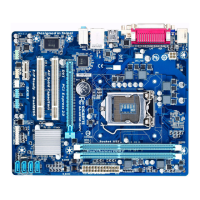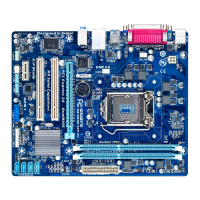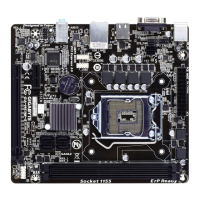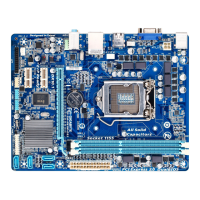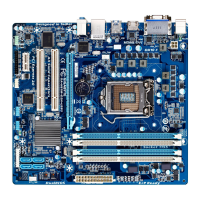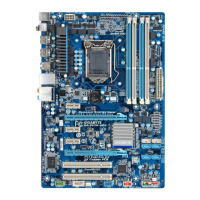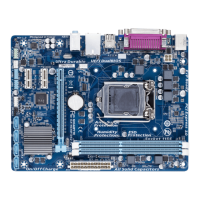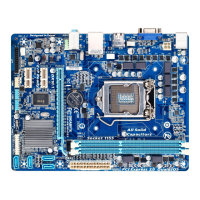Do you have a question about the Gigabyte GA-H61M-S2V-B3 and is the answer not in the manual?
Legal notice regarding copyright and trademarks.
Information about manual usage, copyright, and GIGABYTE's rights.
How to find the revision number on your motherboard.
Guidelines for safely installing the motherboard and components.
Detailed specifications of the motherboard's hardware components.
Step-by-step instructions for installing the CPU and its cooler.
Procedures for installing RAM modules, including Dual Channel configuration.
Guidelines for installing expansion cards like graphics or sound cards.
Explains the function of each connector on the motherboard's rear panel.
Details the various internal headers and connectors on the motherboard.
Explains the ATX power connectors and recommended PSU wattage.
Details CPU and system fan headers and their pinouts.
Describes the SATA connectors and their pinout for connecting storage devices.
Explains the front panel header for power/reset switches and LEDs.
Details front panel audio and USB headers.
Details the legacy serial and parallel port headers.
Explains chassis intrusion detection and power LED headers.
Instructions for clearing CMOS and information about the battery.
Displays the initial screen shown when the BIOS setup program starts.
Overview of the main BIOS setup menu and navigation options.
Section for advanced CPU and memory overclocking and tuning.
Displays current BIOS version, CPU, and memory status.
Settings related to CPU clock ratios and frequencies.
Detailed settings for CPU cores, Turbo Boost, and power management.
Settings for system memory multiplier and frequency.
Comprehensive settings for memory performance and timings.
Detailed timing parameters for memory channels (CAS, tRCD, tRP, etc.).
Controls various voltage settings for CPU, memory, and chipset.
Voltage settings specifically for the CPU.
Adjusts the DDR memory voltage.
Contains various system configuration options like virtualization.
Displays and configures system date, time, and storage devices.
Settings related to boot order, passwords, and system features.
Specifies the sequence for loading the operating system from boot devices.
Configures boot order for CD/DVD, USB, HDD, and network devices.
Settings for BIOS passwords, S.M.A.R.T. capability, and execute protection.
Configures display output and storage access modes.
Configures integrated hardware devices like SATA, USB, and LAN.
Configures system power management features and ACPI states.
Specifies the ACPI sleep state (S1 or S3) when the system suspends.
Configures the power button behavior for shutting down the system.
Configures system wake-up events from various sources.
Sets system passwords, AC power loss behavior, and ErP support.
Displays system voltages, temperatures, and fan speeds for monitoring.
Displays critical system voltages, temperatures, and fan speeds.
Manages CPU fan speed control, including warnings and modes.
Loads the safest BIOS default settings for system stability.
Loads the optimal BIOS default settings for system operation.
Sets passwords for BIOS setup access and system startup.
Saves current BIOS settings and exits the setup utility.
Guide to installing motherboard drivers using the provided disk and Xpress Install.
Information on accessing GIGABYTE's global service and support system.
| Non-ECC | Yes |
|---|---|
| Memory voltage | 1.5 V |
| Memory channels | Dual-channel |
| Memory slots type | DIMM |
| Number of memory slots | 2 |
| Supported memory types | DDR3-SDRAM |
| Maximum internal memory | 16 GB |
| Supported memory clock speeds | 800, 1066, 1333 MHz |
| Processor socket | LGA 1155 (Socket H2) |
| Processor manufacturer | Intel |
| Compatible processor series | Intel Core i3, Intel Core i5, Intel Core i7 |
| Maximum number of SMP processors | 1 |
| Number of SATA II connectors | 4 |
| Number of Parallel ATA connectors | 0 |
| USB 2.0 ports quantity | 6 |
| Certification | RoHS |
| Component for | PC |
| Power source type | ATX |
| Motherboard chipset | Intel® H61 |
| Audio output channels | 7.1 channels |
| Motherboard form factor | micro ATX |
| Compatible operating systems | Windows 7/Vista/XP |
| PCI Express x1 slots | 3 |
| PCI Express slots version | 2.0 |
| Parallel processing technology support | - |
| Bundled software | Norton Internet Security |
| LAN controller | Realtek RTL8111E |
| Ethernet interface type | Gigabit Ethernet |
| BIOS type | AWARD |
| ACPI version | 1.0b |
| BIOS memory size | 64 Mbit |
| Supported storage drive interfaces | SATA II |
| Depth | 195 mm |
|---|---|
| Width | 244 mm |

